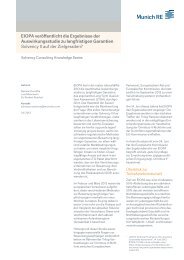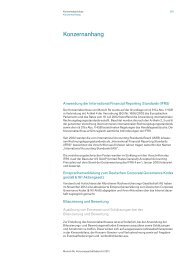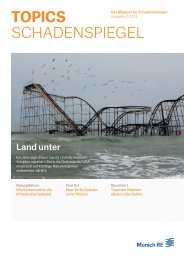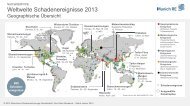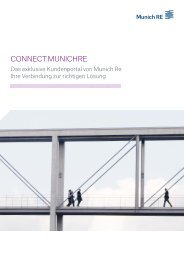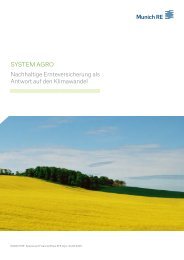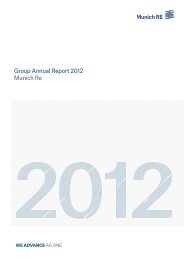Munich Re Group Annual Report 2006 (PDF, 1.8
Munich Re Group Annual Report 2006 (PDF, 1.8
Munich Re Group Annual Report 2006 (PDF, 1.8
Create successful ePaper yourself
Turn your PDF publications into a flip-book with our unique Google optimized e-Paper software.
<strong>Munich</strong> <strong>Re</strong> <strong>Group</strong> <strong>Annual</strong> <strong>Re</strong>port <strong>2006</strong> Notes_Disclosures on the uncertainties of future cash flows from insurance contracts<br />
The development of our claims reserves in the past and the corresponding<br />
run-off results are shown under (21) “Provisions for outstanding<br />
claims”.<br />
A particular sensitivity exists in classes of business with long runoff<br />
periods. This characteristic applies especially to casualty insurance,<br />
where liabilities often manifest themselves with a considerable<br />
time-lag. In addition, changes in court verdicts, new loss categories,<br />
medical inflation and modifications in general life expectancy can<br />
alter the valuation of reserves. The following section discusses the<br />
main areas in the current reserve portfolio where management has<br />
identified the uncertainty to be the greatest.<br />
Asbestos insurance liabilities currently emanating predominantly<br />
from the US and some European counties are an area of concern for<br />
the entire insurance and reinsurance industry. Naturally this also<br />
applies to the <strong>Munich</strong> <strong>Re</strong> <strong>Group</strong>. Since the mid-eighties, industrial<br />
insurers writing business worldwide have found themselves being<br />
confronted with asbestos-related injury losses from policies taken<br />
out decades before. In particular, these include claims under product<br />
liability policies in the USA which manifest themselves after a<br />
Provisions for asbestos and environmental claims<br />
latency period of as long as 30 to 50 years. In response, we have<br />
posted provisions for claims under long-cancelled general liability<br />
policies which provided coverage according to the then-applicable<br />
legal environment.<br />
Significant time lags between major events leading to insurance<br />
claims are exacerbated when it comes to reinsurance claims. Loss<br />
notification often involves a long “chain”: exposure to the loss, manifestion<br />
of an injury, filing of a lawsuit against a defendant, adjudication<br />
of the suit, reporting and payment of an insurance recovery and<br />
then, finally, notification to the reinsurer. Therefore, besides monitoring<br />
these developments on a claim-by-claim level, we also monitor<br />
the development from an industry perspective, as this may be considered<br />
an important early indicator.<br />
In the course of <strong>2006</strong>, we saw rapidly emerging evidence that the<br />
surge in asbestos claims filings that the US industry has experienced<br />
in recent years will impact our <strong>Munich</strong> <strong>Re</strong> America book of business.<br />
Therefore, we have reallocated €465m to asbestos claims reserves<br />
from previously held unallocated risk margins at <strong>Munich</strong> <strong>Re</strong> <strong>Group</strong><br />
level. Altogether, the provisions concerned are as follows:<br />
31.12.<strong>2006</strong> Prev. year<br />
All figures in €m * Gross Net Gross Net<br />
Asbestos 1,932 1,545 1,466 1,168<br />
Environment<br />
* The previous year’s figures have been adjusted to take account of currency translation differences.<br />
440 377 485 409<br />
Other loss scenarios which are highly influenced by the continuously<br />
evolving practice of jurisprudence under tort law currently include<br />
toxic mould, sexual misconduct and construction defects. We will<br />
continue to monitor trends and to respond to the emergence of new<br />
information as appropriate. Given the unpredictable nature of court<br />
decisions and other loss-affecting factors in the markets concerned,<br />
however, it will continue to be difficult to make accurate estimates of<br />
future development.<br />
In the area of bodily injury losses, the <strong>Group</strong> carries a significant<br />
amount of reserves for individual claims where the claimant is<br />
severely injured and is in need of a high degree of individual, specialised<br />
medical treatment and care. US workers´ compensation<br />
business and motor liability business in some European countries<br />
are particularly affected by such claims. In both cases, coverage is<br />
provided for permanent disability cases where the claimant is<br />
expected to live for a considerable length of time and requires sig-<br />
nificant medical attention. Accordingly, the loss provisions are<br />
highly sensitive to inflation in the medical sector and to general life<br />
expectancy. Historical loss development data still embed past coverage<br />
and benefit/inflation levels. As such, historical loss patterns that<br />
are relied upon for traditional actuarial analysis may not be truly<br />
reflective of future emergence; future reported and paid loss<br />
amounts are compared to projected amounts to check the appropriateness<br />
of current and future loss development patterns.<br />
Interest-rate risks<br />
Economically, an interest-rate risk derives from the need to earn a<br />
return on the investments covering the provision that is commensurate<br />
with the discount rate used in measuring the provision. In<br />
balance sheet terms, the interest-rate risk affects the provisions for<br />
outstanding claims only to the extent that the estimated reserve<br />
values are discounted.<br />
205



